Intel Alder Lake DDR5 Memory Scaling Analysis With G.Skill Trident Z5
by Gavin Bonshor on December 23, 2021 9:00 AM ESTScaled Gaming Performance: High Resolution
Civilization 6
Originally penned by Sid Meier and his team, the Civilization series of turn-based strategy games are a cult classic, and many an excuse for an all-nighter trying to get Gandhi to declare war on you due to an integer underflow. Truth be told I never actually played the first version, but I have played every edition from the second to the sixth, including the fourth as voiced by the late Leonard Nimoy, and it is a game that is easy to pick up, but hard to master.
Benchmarking Civilization has always been somewhat of an oxymoron – for a turn based strategy game, the frame rate is not necessarily the important thing here and even in the right mood, something as low as 5 frames per second can be enough. With Civilization 6 however, Firaxis went hardcore on visual fidelity, trying to pull you into the game. As a result, Civilization can taxing on graphics and CPUs as we crank up the details, especially in DirectX 12.
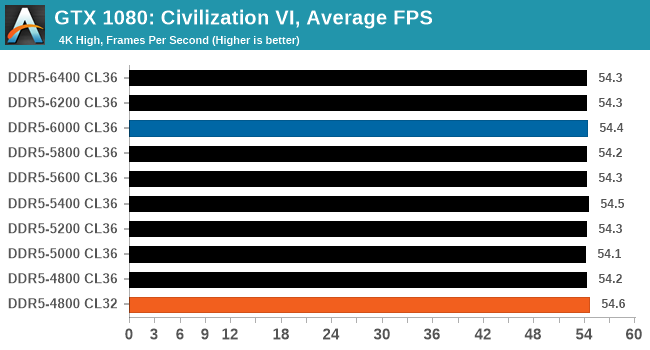

Blue is XMP; Orange is JEDEC at Low CL
Performance in Civ VI shows there is very little benefit to be had by going from DDR5-4800 to DDR5-6400. The results also show that Civ VI actually benefits from lower latencies, with DDR5-4800 at CL32 outperforming all the other frequencies tested at CL36.
Shadow of the Tomb Raider (DX12)
The latest installment of the Tomb Raider franchise does less rising and lurks more in the shadows with Shadow of the Tomb Raider. As expected this action-adventure follows Lara Croft which is the main protagonist of the franchise as she muscles through the Mesoamerican and South American regions looking to stop a Mayan apocalyptic she herself unleashed. Shadow of the Tomb Raider is the direct sequel to the previous Rise of the Tomb Raider and was developed by Eidos Montreal and Crystal Dynamics and was published by Square Enix which hit shelves across multiple platforms in September 2018. This title effectively closes the Lara Croft Origins story and has received critical acclaims upon its release.
The integrated Shadow of the Tomb Raider benchmark is similar to that of the previous game Rise of the Tomb Raider, which we have used in our previous benchmarking suite. The newer Shadow of the Tomb Raider uses DirectX 11 and 12, with this particular title being touted as having one of the best implementations of DirectX 12 of any game released so far.
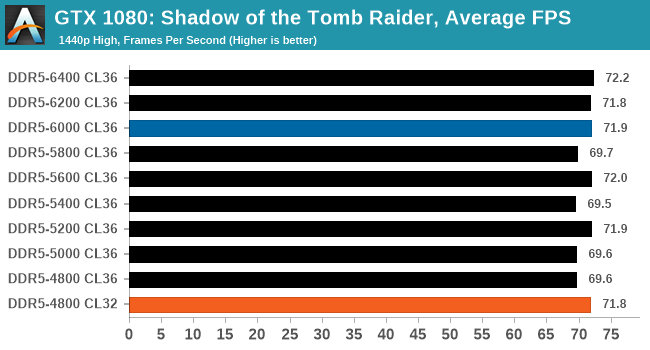
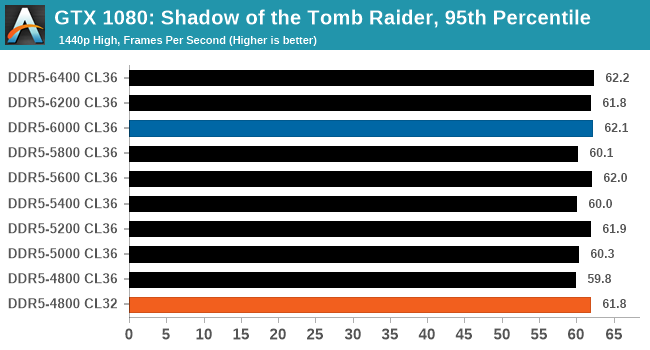
Blue is XMP; Orange is JEDEC at Low CL
Looking at our results in Shadow of the Tomb Raider, we did see some improvements in performance scaling from DDR5-4800 to DDR5-6400. The biggest improvement came when testing DDR4-4800 CL32, which performed similarly to DDR5-6000 CL36.
Strange Brigade (DX12)
Strange Brigade is based in 1903’s Egypt and follows a story which is very similar to that of the Mummy film franchise. This particular third-person shooter is developed by Rebellion Developments which is more widely known for games such as the Sniper Elite and Alien vs Predator series. The game follows the hunt for Seteki the Witch Queen who has arisen once again and the only ‘troop’ who can ultimately stop her. Gameplay is cooperative-centric with a wide variety of different levels and many puzzles which need solving by the British colonial Secret Service agents sent to put an end to her reign of barbaric and brutality.
The game supports both the DirectX 12 and Vulkan APIs and houses its own built-in benchmark which offers various options up for customization including textures, anti-aliasing, reflections, draw distance and even allows users to enable or disable motion blur, ambient occlusion and tessellation among others. AMD has boasted previously that Strange Brigade is part of its Vulkan API implementation offering scalability for AMD multi-graphics card configurations. For our testing, we use the DirectX 12 benchmark.
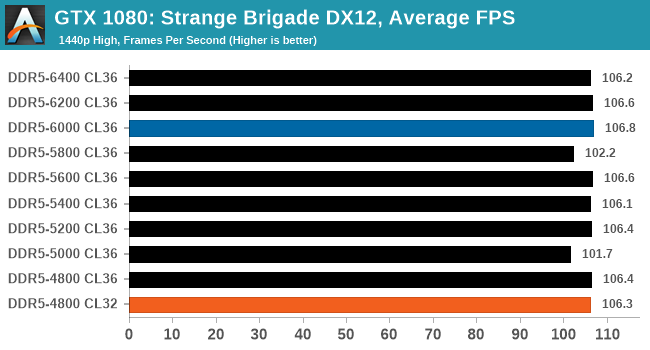
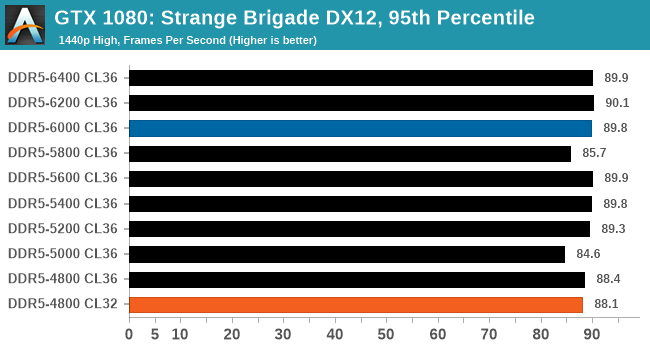
Blue is XMP; Orange is JEDEC at Low CL
Performance in Strange Brigade wasn't influenced by the frequency and latency of the G.Skill Trident Z5 DDR5 memory in terms of average frame rates. We do note however that 95th percentile performance does, for the most part, improve as we increased the memory frequency.


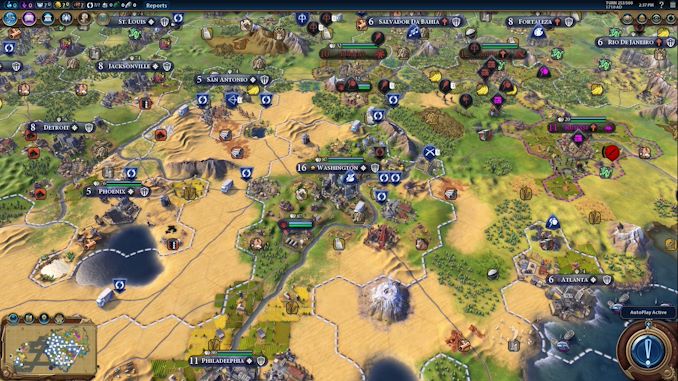
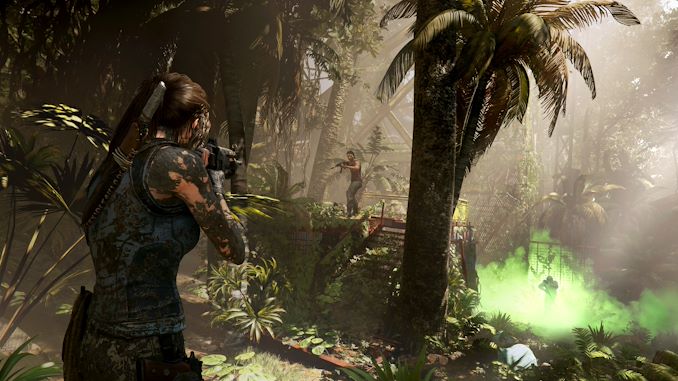









82 Comments
View All Comments
milli - Thursday, December 23, 2021 - link
Are you going to start doing things the way idiots like it? Even when it's clearly wrong?Just because they don't understand it, doesn't mean you have to adhere to their wishes.
Anybody can go to Linus if they want just a show.
Oxford Guy - Friday, December 24, 2021 - link
I’m with Dr. Cutress on this. Anything below 1080 is silly to bother testing in 2021.TheinsanegamerN - Tuesday, December 28, 2021 - link
Unless you're testing memory scaling or CPU scaling, which is what is being tested here.720p/768p has a much larger pool of users then 4k does, so if were going by popularity then why ever bother testing at 4k?
Oxford Guy - Tuesday, December 28, 2021 - link
Mobile casual gaming has a larger pool of users than 1080 on PCs. That doesn't mean tests that are relevant for mobile devices are worth doing on PCs with decent discrete GPUs.4K testing has always been relevant as a demonstration of the wall one hits due to diminishing returns.
TheinsanegamerN - Monday, January 3, 2022 - link
And 720p testing is also relevant as a demonstration of theoretical CPU scaling in games, yet people seem to have a hard on for demanding it's removal from CPU scaling reviews, for some reason.YukaKun - Thursday, December 23, 2021 - link
What if you disable the E-cores and check the ring-BUS speeds relative to the RAM and the benchmark numbers?I have a feeling this may be a similar pain as Zen and the IF.
Regards.
thestryker - Thursday, December 23, 2021 - link
This would be very interesting to check out, and if not on the whole suite maybe just something like WinRAR where we're seeing a lot of scaling already.haukionkannel - Friday, December 24, 2021 - link
HU did test that and disabling E-cores did not help. 1% difference...YukaKun - Friday, December 24, 2021 - link
They didn't do RAM scaling though. And only focused on games.Regards.
mikk - Thursday, December 23, 2021 - link
What the hell, 4k and 1440p with a GTX 1080! This is all heavily GPU bound, this RAM scaling is so useless. What a bad test, I'm spechless.